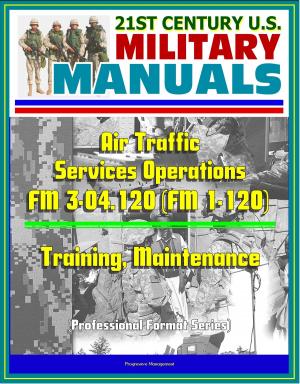Development of Maritime Patrol Aviation in the Interwar Period, 1918-1941: Covering World War I, Rigid Airships, Flying Boat, Bureau of Aeronautics BuAer and OpNav, London Naval Conference
Nonfiction, History, Military, Aviation, Naval| Author: | Progressive Management | ISBN: | 9780463140529 |
| Publisher: | Progressive Management | Publication: | May 6, 2018 |
| Imprint: | Smashwords Edition | Language: | English |
| Author: | Progressive Management |
| ISBN: | 9780463140529 |
| Publisher: | Progressive Management |
| Publication: | May 6, 2018 |
| Imprint: | Smashwords Edition |
| Language: | English |
This excellent report has been professionally converted for accurate flowing-text e-book format reproduction.
The contributions of patrol aviation during World War II as the long-range patrol and reconnaissance arm of the U.S. Navy are well documented, but the development of its origins remain historically under-examined. The goal of this study is to perform an historical investigation of the influential forces that shaped the development of patrol aviation during the interwar period, 1918 to 1941. In order to form a thorough and objective argument, the research approaches these influential forces through an investigation from a strategic, technological, and operational perspective.
From the earliest days of flight, naval leadership in the form of the General Board and OpNav were invested in the strategic concept harbored in the potential of long-range reconnaissance and strike capability of the "flying boat." However, it took over two decades of technological development after 1918 in order to produce an aircraft with the specifications needed to fight a naval war in the Pacific. By the mid-1920s the Navy had designated the aircraft as VP; V for heavier-than-air, and P for patrol. However, the slow speed of development along with the need for a balanced fleet forced Navy leadership to pursue the lighter-than-air program as an alternative solution to the problem of range and endurance with respect to long-range reconnaissance aircraft. In a parallel developmental effort, the Navy approached its material solution to the range and endurance problem by also pursuing rigid airship technology. Though the rigid airship program was discontinued by 1936, the Navy continued to innovate with non-rigid lighter-than-air technology until 1962 when airship operations were terminated.
CHAPTER 1 INTRODUCTION * Background * Primary Research Question * Limitations * Delimitations * Analytical Narrative * Methodology * Significance * CHAPTER 2 LITERATURE REVIEW * CHAPTER 3 1918 to 1921: POST-WAR FOUNDATIONS * Heavier-than-air Craft through the End of WW I * Lighter-than-air Craft through the End of WW I * Post-war Drawdown and the Beginning of a Strategic Shift toward the Pacific * 1919 and the Foundation of Naval Aviation Policy * CHAPTER 4 1922 to 1931: BUILDING THE FUTURE * The Treaty System * 1922 Washington Naval Arms Limitation Conference * The Centralization of Administrative Bureaucracy: BuAer * Private Industry: A Balance of Procurement and Proprietary Design Control * Lighter-than-air Development: Rigid Airships * Heavier-than-air Developments: The PN Series Flying Boat * 1930 London Naval Arms Limitation Conference * Fleet Reorganization in Support of Development for a Pacific War * CHAPTER 5 1932 to 1941: AFTER LONDON * Strategy and Technology Challenges * Organizational and Tactical Developments in the Wake of the London Naval Conference * Operational Refinement of Patrol Aviation: Fleet Exercises and Annual Fleet Problems * CHAPTER 6 CONCLUSION * Other Observations * Areas for Continued Research * Final Thoughts * BIBLIOGRAPHY
This excellent report has been professionally converted for accurate flowing-text e-book format reproduction.
The contributions of patrol aviation during World War II as the long-range patrol and reconnaissance arm of the U.S. Navy are well documented, but the development of its origins remain historically under-examined. The goal of this study is to perform an historical investigation of the influential forces that shaped the development of patrol aviation during the interwar period, 1918 to 1941. In order to form a thorough and objective argument, the research approaches these influential forces through an investigation from a strategic, technological, and operational perspective.
From the earliest days of flight, naval leadership in the form of the General Board and OpNav were invested in the strategic concept harbored in the potential of long-range reconnaissance and strike capability of the "flying boat." However, it took over two decades of technological development after 1918 in order to produce an aircraft with the specifications needed to fight a naval war in the Pacific. By the mid-1920s the Navy had designated the aircraft as VP; V for heavier-than-air, and P for patrol. However, the slow speed of development along with the need for a balanced fleet forced Navy leadership to pursue the lighter-than-air program as an alternative solution to the problem of range and endurance with respect to long-range reconnaissance aircraft. In a parallel developmental effort, the Navy approached its material solution to the range and endurance problem by also pursuing rigid airship technology. Though the rigid airship program was discontinued by 1936, the Navy continued to innovate with non-rigid lighter-than-air technology until 1962 when airship operations were terminated.
CHAPTER 1 INTRODUCTION * Background * Primary Research Question * Limitations * Delimitations * Analytical Narrative * Methodology * Significance * CHAPTER 2 LITERATURE REVIEW * CHAPTER 3 1918 to 1921: POST-WAR FOUNDATIONS * Heavier-than-air Craft through the End of WW I * Lighter-than-air Craft through the End of WW I * Post-war Drawdown and the Beginning of a Strategic Shift toward the Pacific * 1919 and the Foundation of Naval Aviation Policy * CHAPTER 4 1922 to 1931: BUILDING THE FUTURE * The Treaty System * 1922 Washington Naval Arms Limitation Conference * The Centralization of Administrative Bureaucracy: BuAer * Private Industry: A Balance of Procurement and Proprietary Design Control * Lighter-than-air Development: Rigid Airships * Heavier-than-air Developments: The PN Series Flying Boat * 1930 London Naval Arms Limitation Conference * Fleet Reorganization in Support of Development for a Pacific War * CHAPTER 5 1932 to 1941: AFTER LONDON * Strategy and Technology Challenges * Organizational and Tactical Developments in the Wake of the London Naval Conference * Operational Refinement of Patrol Aviation: Fleet Exercises and Annual Fleet Problems * CHAPTER 6 CONCLUSION * Other Observations * Areas for Continued Research * Final Thoughts * BIBLIOGRAPHY















